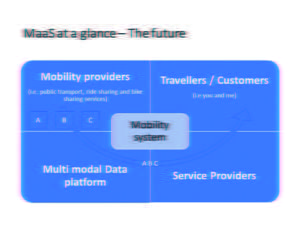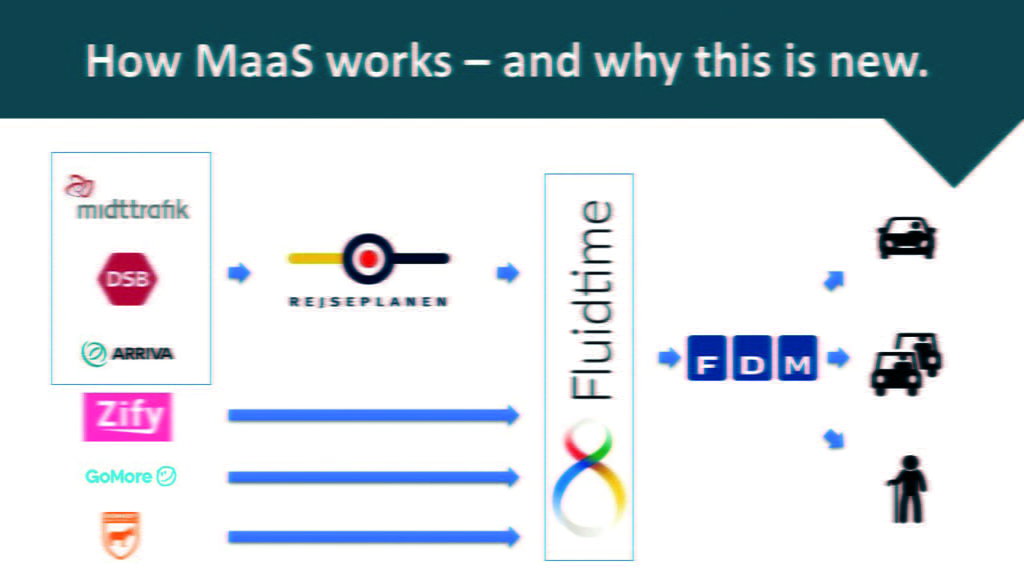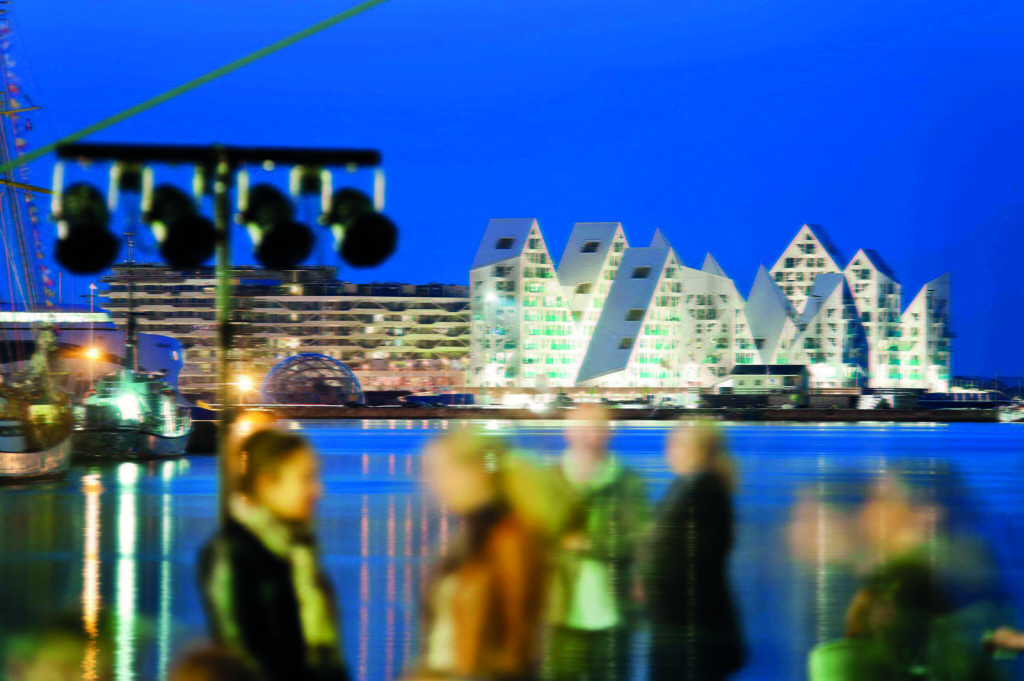The journey to MaaS
Through a pilot project of a real solution for Mobility as a Service, municipalities in Business Region Aarhus, Denmark, want to investigate the possibility for creating a more efficient mobility system by integrating public and private mobility services, writes Gustav Friis


Apilot project in Denmark’s second city, Aarhus, is demonstrating a new way of organising the mobility system in and around a city. The innovative demonstration project will combine public transport solutions with private peer-to-peer ridesharing in an integrated solution in a real-life environment. The mobility solution will be based on the principles of Mobility as a Service (MaaS).
The transport demand in Aarhus is increasing as the city is growing. During the last 10 years, the number of inhabitants has increased by 11 per cent while the number of cars has increased by 27 per cent1 . At the same time the average number of people in those cars has been decreasing since the first count by the Danish Road Directorate in 1981.
At that time, the average number was well above 1.8, whereas the number in recent times is around 1.4 in average. Transport related to commuting constitute the lowest average number of people in the cars with only 1.052 . So, for each 100 passenger cars on the roads during peak hours, only five people besides the driver of the car will be transported.
Similar challenges are faced in the realm of public transport. Public transport planning and management seeks to limit the number of free seats on the buses, i.e. through a big restructuring of the public transport network in Aarhus in 2011 and with the implementation of the light rail system in 2017. Avoiding free seats lowers the public payment per passenger. However, an emerging challenge for the efficiency of public transport is congestion. The longer the buses must operate on the roads to provide the same (or even reduced) service for the user, the more expensive it becomes to operate. Getting more people to use ridesharing in congested areas will therefore also make the public transport system more efficient. However, there might be a risk of also pushing towards a system that makes public transport less competitive and therefore the number of free seats might increase. Therefore, continuous planning and adjustments should continue for the public transport system.
Better occupancy of each car will potentially have a great impact on the mobility system. Ridesharing, where you share a specific ride with a peer, will increase car occupancy and make the system more efficient. With peer-to-peer (P2P) ridesharing, you as a driver or a passenger share the ride – the specific journey – with your peer and will be in the vehicle along with your peer for the whole journey or a part of it.
Ridesharing is an important mode of transport within MaaS, as the car still will continue to be part of an efficient and flexible mobility system. It means that the climate challenges about congestion and CO2 emissions still will apply. Ridesharing is also seen as one of the major challenges in a MaaS system because it is a mode of transport that requires a change in the users’ mobility behaviour. Behavioural change and the willingness to buy-in on a service from the user perspective will be a very important component of the project, and incentives will be tested to get travellers on board.
"All stakeholders are crucial in setting up a sustainable Mobility as a Service solution. If the solution is not solving any societal challenges, there will be no need for the public sector to engage in it"

TAKING MaaS TO THE NEXT LEVEL

The key objective is an efficient mobility system that supports both economic, social and environmental sustainability objectives. It contains both the demand side of mobility and the supply side. An efficient mobility system provides better mobility for the same price or less, for both society and the traveller. It makes it easier to use all modes of transport in a flexible and easy way - as an attractive alternative to single occupancy cars.
The efficient mobility system is complex. It works with many stakeholders, both private and public, and is set to replace a well-established and functioning set of mobility services. The MaaS project in Business Region Aarhus will in 2018 and 2019 take us closer to this, by thoroughly analysing each component in the realm of MaaS as a lever for both the supply and demand side of the mobility system.
The figures on the previous page show simplistically how the mobility system works today and what system that the demonstration project in Business Region Aarhus is demonstrating. Mobility providers are providing mobility (A, B, C) such as public transport or ride sharing directly to the traveller, but with no coordination between this, hence the traveller has no opportunity to plan a multimodal journey combining public and private modes, nor can the traveller pay them together. However, it is worth mentioning that all public transport in Denmark already has a multimodal planning opportunity (Rejseplanen) and payment method (Rejsekortet). The demonstrated system is visualised in opposite. In other words, the project will demonstrate how mobility can be provided to the travellers as an integrated service – MaaS. How the demonstration will be carried out will be described in more detail in the section below, but the main idea of the demonstration is to bring the various stakeholders together, from the mobility providers in the system, through the data platform and service provider and all the way to the traveller.
As shown in the diagram opposite, there is a strong collaboration on the public transport side, since both Rejseplanen and Rejsekortet are owned by the national train operator (DSB) and the public transport authorities. There is a common understanding that the provided mobility is mainly public transport, the travel planner is Rejseplanen and the payment method (although amongst local solutions) is Rejsekortet. At the end of the day, the mission is to bring more people to public transport.
On the other hand, you will have a private mobility provider such as GoMore in Denmark and Zify in India and France, providing a system for peer-to-peer ride sharing. Both offers, and bookings are made via a dedicated app and they have separate payment systems. The perspectives from the companies are business-oriented.
A dedicated data sharing platform will gather all relevant mobility data from the mobility providers as described above. The platform will ensure that data is easy accessible for other services, that data can be processed in the same way and thereby be comparable.
To acquire the data-sharing platform, a Public-Private Innovation Partnership (PPI) is established. The PPI facilitates innovation between public and private actors, in this case between a data-sharing platform and the local authorities in Aarhus. The platform will be set up and operated by the Austrian company Fluidtime, whilst the public partner (The City of Aarhus) will define requirements.
In June 2018, an agreement between Business Region Aarhus and the Danish Federation of Motorists (FDM) was established. FDM will in the demonstration project serve as the service provider of the system. This meaning that FDM will present the integrated data from the FluidHub (Fluidtime’s data management platform). The Danish Federation of Motorists is in this particular case a very interesting partner, since they are already in close contact with the segment of people that would be interesting to influence; namely car drivers.
To be able to implement a successful MaaS system in Business Region Aarhus that both take into consideration, (1) the objectives of reducing congestion and thereby improving the mobility system in cities; (2) providing better and more efficient mobility in areas that are scarcely populated and where public transport therefore easily gets ineffective.
Car drivers are the key target group. The question to answer for a successful implementation will therefore be how to get drivers to open their journeys to passengers. Further, how to get current car drivers to become passengers in other car drivers’ cars.
How the value stream of the system will be, is still not clear and will be tested throughout the demonstration. Many working questions will be relevant to address to the demonstration of MaaS.
All stakeholders are crucial in setting up a sustainable Mobility as a Service solution. If the solution is not solving any societal challenges, there will be no need for the public sector to engage in it. If there are no economic benefits for the private actors, then there is no need for them to engage in the solution.
Cities are important actors and good places to test advanced transport technologies like MaaS because they can work with political tools (incentives and frameworks) to change citizens’ mobility behaviour.
As cities, we define the framework for incorporating MaaS solutions together with the development of the city. Aarhus and its surrounding municipalities have an interesting, mixed context of dense urban areas and rural areas. It is an obvious setting to make a pilot project that demonstrates elements of a MaaS system, focusing on ridesharing because it both contains the challenges of mobility found in cities and in the rural areas where the car still plays an important role in the mobility system.
FYI
NOTES
[1] Numbers from Statistics Denmark: https://www.dst.dk/en
[2] https://www.modelcenter.transport.dtu.dk/-/media/Centre/Modelcenter/modeller-og-publikationer/Faktaark/2014-Faktaark_personer_per_koeretoej.ashx?la=da&hash=BF3E918DABBEBE2EFD4D914C6B6294D093EFC45B
